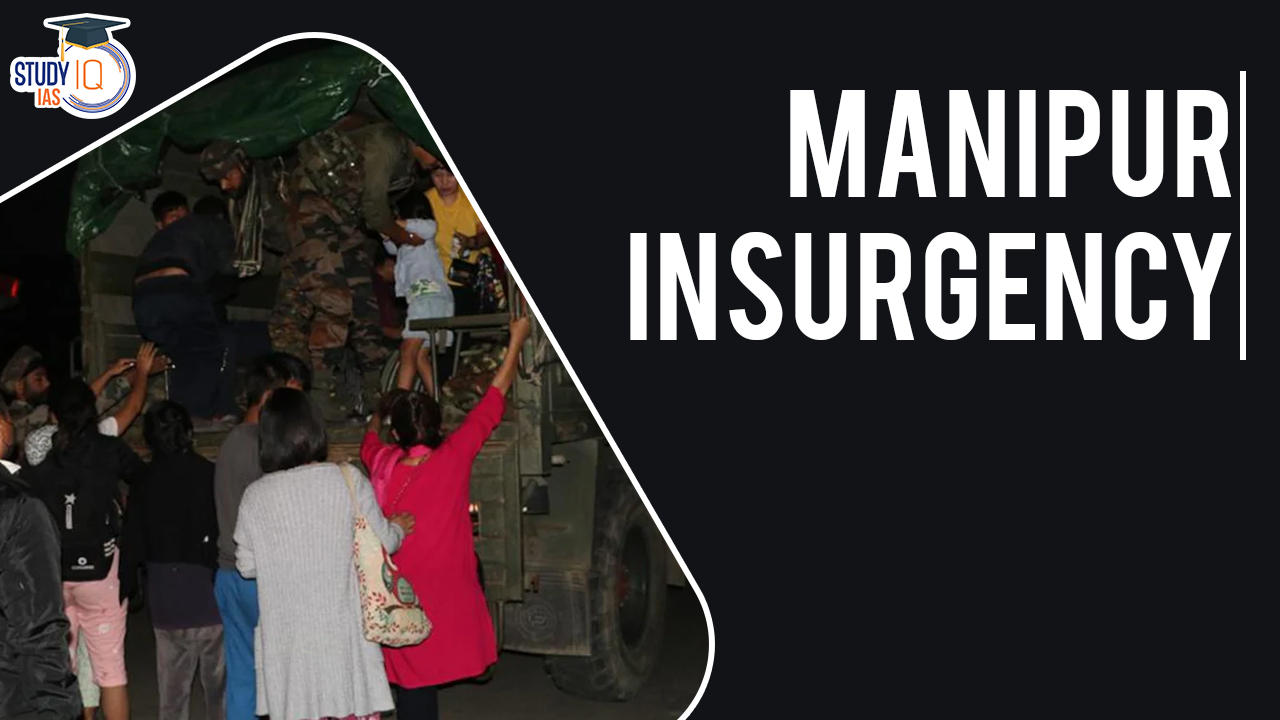Table of Contents
Context: Violent clashes have recently broken out at various places in Manipur during the course of a ‘Tribal Solidarity March’ by the All Tribal Students’ Union of Manipur (ATSUM).
Understanding the Insurgency
Merger of Manipur with the Union of India:
The merger of Manipur with India took place through a process that was marked by negotiations, agreements, and ultimately, the signing of the Merger Agreement.
- Before 1947: Manipur was a princely state under British colonial rule. The Maharaja of Manipur, Bodhachandra Singh, was the ruler of the state.
- 1947: India gained independence from British colonial rule. The British withdrew from India, and the various princely states were given the choice to join either India or Pakistan or remain independent.
- August 1947: The Maharaja of Manipur signed the Instrument of Accession, agreeing to accede to the Indian Union.
- June 1948: The state of Manipur held an election based on universal adult franchise, and a constitutional monarchy was established.
- September 1949: The Government of India pressured the Maharaja of Manipur into signing the Merger Agreement, which effectively merged Manipur with the Indian Union.
- 21st January 1972: Manipur, along with Meghalaya and Tripura, became a full-fledged state under the North Eastern Region (Reorganisation) Act, 1971.
Ethnicity of Manipur
- The Meiteis are the largest community in Manipur. There are 34 recognized tribes, which are broadly classified as ‘Any Kuki Tribes’ and ‘Any Naga Tribes’.
- The central valley in the state accounts for about 10% of the landmass of Manipur, and is home primarily to the Meitei and Meitei Pangals who constitute roughly 64.6% of the state’s population.
- The remaining 90% of the state’s geographical area comprises hills surrounding the valley, which are home to the recognized tribes, making up about 35.4% of the state’s population.

Who are the Meiteis?
- Meiteis are the dominant community of Manipur, found majorly in Imphal plains. They can also be found in the states of Assam, Tripura, Nagaland, Meghalaya, and Mizoram. Some of them reside in Myanmar and Bangladesh.
- Religious affiliation: A majority of them identify as Hindu, while about 8% are Muslim.
- Language: They speak the Meitei language, which is officially known as Manipuri. It belongs to the Tibeto-Burman language family.
- Manipuri was included in the Eighth Schedule of the Indian Constitution in 1992.
- Art and Culture:
- Maliyafam Palcha Kumsing is the traditional calendar of the Meitei community, which has 12 months and a 7-day week, like the Gregorian calendar.
- The classical Manipuri dance form has its roots from the Lai Haraoba dance form.
- Martial art form Tang-ta originated from Meitei Knights.
- Sagol Kangjei, which is the earliest form of modern-day Polo, traces its origin to Manipur and Meiteis.
- Mukna Kangjei is a type of traditional wrestling popular amongst the Meiteis.
Meitei’s Demand for ST Status
- Recent Plea:
- There was a recent plea before the Manipur High Court by the Meetei (Meitei) Tribe Union, seeking directions to the Manipur government to submit a recommendation to the Union Ministry for Tribal Affairs for the inclusion of the community in the list of Scheduled Tribes in the Indian Constitution, as a “tribe among tribes in Manipur”.
- Arguments in Favour:
- “Tribal” Status pre-independence: In their plea before the High Court, the petitioners argued that the Meitei community was recognised as a tribe before the merger of the princely state of Manipur with the Union of India in 1949, and that it lost its identity as a tribe after the merger.
- To preserve their culture: It was also argued that the demand for ST status arose from the need to “preserve” the community, and “and save the ancestral land, tradition, culture and language” of the Meiteis.
- Constitutional Safeguard: There has also been an organised push in support of this demand since 2012, led by the Scheduled Tribes Demand Committee of Manipur (STDCM).
- The STDCM stated that because of being left out of the ST list, “the community has been victimized without any constitutional safeguards to date.
- Decline in Population: It claimed that the Meitein/Meetei have been gradually marginalised in their ancestral land and that their population which was 59% of the total population of Manipur in 1951 has now been reduced to 44% as per 2011 Census data.
- Meitei community members had also filed contempt proceedings against the Hill Areas Committee (HAC) of the Manipur Assembly for passing a resolution opposing their inclusion under Scheduled Tribe (ST).
Hill Areas Committee (HAC)
- HAC is the highest decision-making body in Manipur at the legislative level to oversee the planning, implementation and monitoring of all development activities in the hill areas.
- HAC is constituted under the Manipur Legislative Assembly (Hill Areas Committee) order, 1972. It comprises of all MLAs elected from the hill areas of the State as its members.
- Powers: Manage resources, sanitation services and primary education, public health and undertake administrative and welfare services including development and economic planning.
Manipur High Court’s Ruling
- The court directed the government to consider the inclusion of the Meetei/Meitei community in the tribe list of Manipur.
- It observed that the petitioners and other groups have been fighting for a long time for this inclusion, suggesting that it is an important issue for the community.
- The court has directed the government to submit its recommendation after considering the case of the petitioners, preferably within four weeks of receipt of the order.
Reasons for Opposition by other Tribal Groups
The demand for ST status for the Meitei community has long been opposed by the state’s tribal groups.
- Dominance of Meiteis: One of the reasons cited for the opposition is the dominance of the Meiteis, both in population and in political representation, since 40 out of 60 Assembly constituencies of the state are in the valley.
- Risk of Job Opportunities: The ST communities of Manipur have been consistently opposing to the inclusion of fearing the loss of job opportunities and other affirmative actions granted to STs by the Constitution of India to a much advanced community like the Meitei.
- Academically Advanced Groups: The tribal groups say the Meiteis have a demographic and political advantage besides being more advanced than them academically and in other aspects.
- Other arguments: These include the fact that:
- the Manipuri language of the Meiteis is included in the Eighth Schedule of the Constitution and
- that sections of the Meitei community which is predominantly Hindu are already classified under Scheduled Castes (SC) or Other Backward Classes (OBC), and have access to the opportunities associated with that status.
Other Reasons for the Insurgency
- Another major reason for the discontent has been the state government’s notices claiming that 38 villages in the Churachandpur-Khoupum Protected Forest area (in Churachandpur and Noney districts) are “illegal settlements” and that its residents are “encroachers”.
- Following this, the government set out on an eviction drive claiming that the people living there “were encroaching reserved forests, protected forests and wildlife sanctuaries for poppy plantation and drugs business” which resulted in clashes.
- Kuki groups have claimed that the eviction is a violation of Article 371C, which confers some administrative autonomy to the tribal-dominated hill areas of Manipur.
The Criteria for ST Status
- The criteria for ST status are primitive traits, distinctive culture, backwardness, geographical isolation, and shyness of contact with the large community.
The Process of Inclusion in the ST List
- The process of adding tribes to the ST list starts with a recommendation from the State governments.
- It is sent to the Tribal Affairs Ministry, which reviews and sends them to the Registrar General of India, Under the Home Ministry for approval.
- After approval, it is sent to the National Commission for Scheduled Tribes and then sent to the Cabinet for a final decision.
- Once the cabinet finalizes it, then it introduces a bill in the parliament to amend the Constitution (Scheduled Castes) Order, 1950, and the Constitution (Scheduled Tribes) Order, 1950.
- After the amendment bill is passed by both the Lok Sabha and Rajya Sabha, the President’s office takes the final decision under Articles 341 and 342 of the Constitution:
Benefits in the Inclusion in the ST List
- Some of the major benefits include post-matric scholarship, overseas scholarship and the national fellowship, besides education, concessional loans from the National Scheduled Tribes Finance and Development Corporation, and hostels for students.
- In addition, they will also be entitled to benefits of reservation in services and admission to educational institutions as per the government policy.
Status of Scheduled Tribes in India
- As per Census-1931, Schedule tribes are termed as “backward tribes” living in the “Excluded” and “Partially Excluded” areas. The Government of India Act of 1935 called for the first time for representatives of “backward tribes” in provincial assemblies.
- The Constitution does not define the criteria for recognition of Scheduled Tribes and hence the definition contained in 1931 Census was used in the initial years after independence.
- However, Article 366(25) of the Constitution only provides process to define Scheduled Tribes: “Scheduled Tribes means such tribes or tribal communities or parts of or groups within such tribes or tribal communities as are deemed under Article 342 to be Scheduled Tribes for the purposes of this Constitution.”
- 342(1): The President may with respect to any State or Union Territory, and where it is a State, after consultation with the Governor, by a public notification, specify the tribes or tribal communities or part of or groups within tribes or tribal communities as Scheduled Tribe in relation to that State or Union Territory.
- The Fifth Schedule of the Constitution lays out provision for Administration and Control of Scheduled Areas and Scheduled Tribes.
- The Sixth Schedule deals with the administration of the tribal areas in Assam, Meghalaya, Tripura and Mizoram.
Importance of NE Region and steps to curb NE Insurgency
Northeast region of India is strategically important for India in several ways:
- National Security: The region shares a long international border with neighboring countries like China, Myanmar, Bhutan, Bangladesh, and Nepal. Therefore, the region’s strategic location is significant for India’s national security.
- Economic Importance: The Northeast region is rich in natural resources such as oil, natural gas, coal, limestone, and forests, and has great potential for tourism and exports. The region is also known as the “growth engine” of India due to its economic potential.
- Carbon Sink: The dense forest cover of the Northeast region plays an important role in mitigating climate change as a carbon sink. The region’s forests absorb a significant amount of carbon dioxide, thus helping in reducing the carbon footprint.
- Act East Policy: The Northeast region has the potential to act as the Indian ‘Gateway to Southeast Asia’ under India’s Act East Policy. The region’s proximity to Southeast Asian countries could provide new economic opportunities for India.
- Cultural Diversity: The Northeast region is home to various ethnic groups and has a rich cultural heritage. The region’s unique cultural identity is an important part of India’s diverse culture and heritage.

Steps to Curb Insurgency for a Secure North East
- Addressing the root causes of insurgency: It is important to address issues such as unemployment, poverty, discrimination, lack of infrastructure, and basic amenities in the region to prevent the emergence of new insurgent groups.
- Dialogue with insurgent groups: The government should initiate a dialogue with the insurgent groups to understand their demands and find a peaceful solution to their grievances.
- Strengthening intelligence and security operations: Effective intelligence gathering and security operations can help prevent insurgent groups from carrying out attacks.
- Repeal of AFSPA: The controversial Armed Forces Special Powers Act (AFSPA) should be repealed to improve the human rights situation in the region.
- Encourage people’s participation: The government should encourage the participation of the people of the region in the decision-making process to promote a sense of ownership and belonging.
- Strengthening the legal system: The government should ensure that the legal system is fair and transparent to avoid the abuse of power by security forces. The Assam Rifles and the Indian Army since independence have been working towards creating a peaceful environment for the civil government to function.
- Strengthening ties with neighboring countries: Strengthening economic and diplomatic ties with neighboring countries can help promote regional stability and security.


 SSC Stenographer 2024 Notification Out a...
SSC Stenographer 2024 Notification Out a...
 IB SA MTS Final Result 2024 Out at mha.g...
IB SA MTS Final Result 2024 Out at mha.g...
 Model Skill Loan Scheme, Eligibility, Re...
Model Skill Loan Scheme, Eligibility, Re...

















